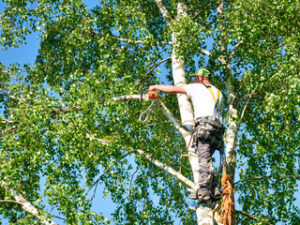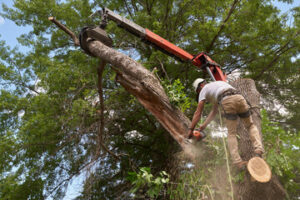Proper tree maintenance enhances a property’s curb appeal. A healthy, well-shaped tree adds value to a home or business, while a neglected one can impose costly damage on structures and people.

Proactive inspections can identify underlying problems that may impact a tree’s health, such as insect infestations or diseases. Correcting these issues at their early stages prevents them from causing major structural damage or safety hazards. Contact Lee Tree Service for professional help.
In any line of work, safety is always a top priority. But for tree service workers, this is even more true. This is because tree cutting involves working in a hazardous environment, putting them at risk of a variety of injuries and accidents.
As such, the best way to protect these workers is to take preventative measures. This is why a reputable tree service will always conduct a thorough inspection of the site prior to starting any work, ensuring that all equipment is in good condition and that there are no potential hazards present. This also helps them to determine the safest ways to approach a particular tree and establish proper safety protocols.
A thorough safety inspection also helps to reduce the risk of injury to workers and damage to property as a result of their work. They should look for signs of disease, insect infestation, or structural issues that could put the tree at risk during high winds. They should also check for excessive leaning, as this could cause a tree to fall and damage structures or vehicles below it. Finally, they should evaluate the condition of the trees and recommend any necessary repairs or removals to keep them safe.
Once they have a clear understanding of the condition of the trees and the surrounding area, they can then develop a detailed plan for the work to be done. This may include identifying and clearing any obstacles or power lines that are in the way, or may be at risk of being hit by falling branches. They may also identify a drop zone and make sure that any tools or objects being dropped can safely reach the ground without hitting any people or structures.
They will also take care to notify any neighbors of the work being done, as this is respectful and courteous and can help ensure that they are kept informed about what is going on nearby their homes. They should also be able to provide clear and concise estimates that detail all the services that will be provided, so that there are no surprises or hidden fees once the job is completed. This is a sign of a company that puts their customers first and values the safety of all parties involved.
Aesthetics
A well-maintained landscape provides an impression of pride and investment, elevating the value of your home. Among other things, a healthy, thriving yard adds curb appeal and sets the stage for first impressions by potential buyers or tenants. A professional tree service can help maintain your property’s visual appeal by keeping the trees on your property healthy and looking great. This includes proper pruning, mulching, and pest control. Additionally, they can recommend planting and placement options that will complement your property’s architectural features.
Unlike many DIY and unlicensed non-professional tree services, a professional tree service is equipped with specialized machinery and trained to handle potentially hazardous tasks without risking your safety or the safety of others. In addition, they are licensed and insured, giving customers peace of mind that their property is in good hands. This includes comprehensive liability insurance and workers’ compensation coverage, which covers the cost of any accidents or damage that may occur during tree care operations.
Trees are a vital part of the natural environment, offering shade, reducing energy use, and enhancing property values. However, they also require regular maintenance to ensure their health and structural integrity. In addition to improving a home’s aesthetics, well-maintained trees contribute to ecological sustainability by providing a habitat for various wildlife species and improving the overall quality of the local ecosystem. Professional tree services utilize eco-friendly practices that help preserve the environment and promote a healthier community.
When choosing a professional tree service, it’s important to find one that has a proven track record of customer satisfaction. Look for services that have strong referrals, a positive reputation in the industry, and a commitment to ongoing education. Moreover, make sure that the company has an arborist on staff who can provide expert insight into your trees’ needs. A qualified arborist will be able to diagnose and treat disease, insect infestations, and other issues that affect a tree’s health, preventing them from growing out of control. They will also be able to identify problems that are not immediately apparent, allowing them to take preventative measures before they become serious hazards.
Longevity
Trees add beauty to landscapes and value to property, enhancing the environment while providing oxygen and improving air quality. As such, they need regular care to thrive. Professionals can spot early signs of declining health, such as yellowing leaves and thinning canopies, and perform interventions to prevent or slow the loss of a tree’s lifespan.
While some species are genetically predisposed to longer lifespans, the environmental conditions they live in significantly impact their longevity. For example, trees that are planted too deeply or in poor soil conditions tend to have shorter lifespans than those planted properly. Additionally, urbanization and pollution can significantly reduce a tree’s longevity by disrupting natural water cycles, killing or damaging roots, and introducing harmful organisms.
Proper care can increase a tree’s longevity by maintaining proper root health, preventing insect infestations, and removing dead or diseased branches. Tree services also provide preventive maintenance by identifying and addressing potential issues before they cause damage, saving homeowners time and money on costly emergency tree removal and repairs.
The ability to upsell premium services can also improve tree service revenue, ensuring that clients are receiving the best possible care for their investment. For example, tree pruning or trimming can improve a tree’s health by reducing risk of injury or disease and promoting air circulation, whereas soil care programs can help ensure that a tree is planted in the right place at the proper depth.
Training can further enhance a tree service business’s profitability by increasing customer retention rates, improving team performance, and reducing operational costs. Additionally, offering educational workshops on topics such as tree planting, pest identification, and the importance of sustainable forestry contributes to overall community sustainability by building a stronger tree care culture.
A reputable tree service provider will clearly state their safety protocols and procedures, and demonstrate a clear understanding of the impact that their work has on the surrounding ecosystem. They will be able to explain how they plan to manage risks, whether through the use of mechanical controls such as pruning or the strategic introduction of predators and parasites, or chemical treatments such as fungicides or insecticides.
Environment
Trees are not just beautiful natural landscape elements, they also play a vital role in the environment. They provide a multitude of ecological benefits like carbon sequestration, climate change mitigation, biodiversity preservation, soil stabilization, and watershed protection. Proper tree care practices not only contribute to these functions, but they also protect and enhance the value of residential properties.
Aside from enhancing the visual appeal of property gardens, regular tree maintenance helps prevent storm damage and prevents the need for costly removals in the future. Regular trimming and pruning improves the health of the trees, ensuring they are better equipped to withstand upcoming storms and high winds. This is crucial to preventing expensive damages and minimizing liability risks.
Another important measure in reducing environmental impacts is protecting wildlife habitats during removal and relocation activities. By carefully assessing potential habitats and taking precautionary measures, eco-friendly tree service companies can ensure that wildlife is not disturbed or relocated. This is essential to maintaining the balance of local ecosystems, limiting erosion, and protecting water quality.
In addition, eco-friendly tree services support reforestation efforts to replace and restore deforested areas. Incorporating reforestation as part of tree service activities helps reduce the demand for wood products and other non-tree-based materials, while also helping to improve the overall well-being of communities.
The importance of environmental measures in tree care not only increases customer satisfaction, but it also enables businesses to achieve higher profit margins and increase market share. Offering eco-friendly solutions leads to a rise in competitive differentiation and customer retention, while allowing business owners to invest more in green technology and staff training. This translates into higher profitability and offsets seasonal fluctuations in demand. A consistent customer retention strategy paired with upselling and subscription-based models further enhances tree service business growth.
